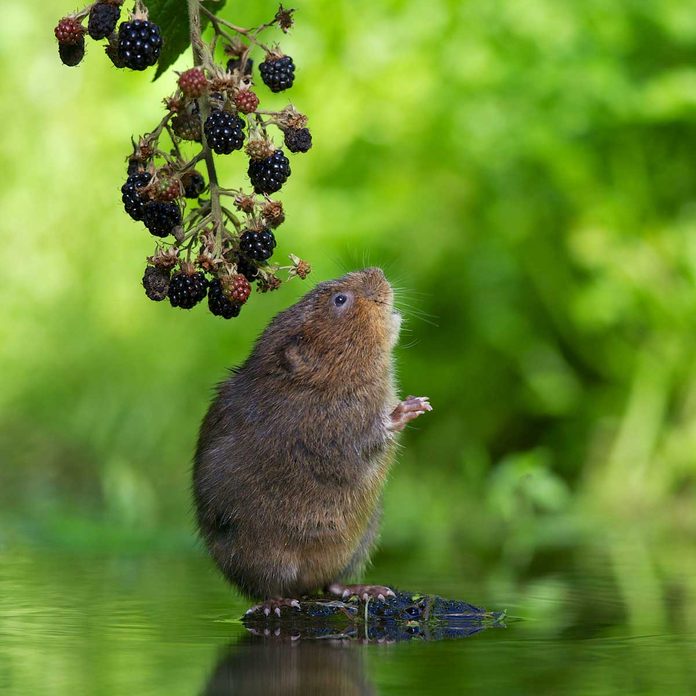How to Get Rid of and Prevent Garden Voles
Updated: Apr. 18, 2023

Voles and moles both dig up your yard, but they’re different in many ways. Here’s what you need to know about voles and how to get rid of them.
On This Page
What Is a Vole?
Voles are rodents that closely resemble mice or hamsters. “They are often called field mice because of their tendency to choose fields in which to live,” says Dr. Nancy Troyano, board certified entomologist for Ehrlich Pest Control. Although voles look like mice, they can be distinguished by their hair-covered tails, rounder heads, smaller ears and more stout bodies.
Voles are small garden pests. According to Troyano, they grow between three to nine inches long. What they lack in size, they make up for in numbers. Voles “can have up to 10 litters a year,” says Troyano. “Just a couple of voles can produce over 100 offspring in a short amount of time.” That’s why it’s so important get rid of voles before an infestation gets out of hand.
How Is a Vole Different From a Mole?
While moles and voles dig up your yard, they differ in appearance and behavior. “Moles are not rodents, but small mammals that spend most of their time underground, digging tunnels,” says Zachary Smith, president of Smith’s Pest Management, a certified pest control company in San Jose, Cal. specializing in vole control.
Moles have large feet and claws that are perfect for burrowing. A mole’s head has a long pointed snout, with such tiny eyes and ears that it looks like it has none. Watch out for these signs that mean you have moles in your yard and learn how to repair mole holes in your lawn.
While voles munch on your yard’s vegetation, moles are predatory. They “feed on earthworms, grubs, beetles and other animals or arthropods in the soil,” says Troyano. Moles damage your garden with their digging, not their eating habits. Here’s how you can get rid of them.
What Do Voles Eat?
Voles are herbivorous for the most part. “They love eating plants, tubers and bulbs, as well as the bark and roots of trees,” says Smith. They’ll treat your garden like an all-you-can-eat buffet, leaving you with droopy, dying leftovers. If their favorite foods aren’t available, Troyano explains that voles “are also opportunistic and will eat dead mice and other rodents.”
How to Get Rid of Voles
Smith recommends five steps for eradicating voles:
Remove Vegetation
Start by getting rid of voles’ habitat. They don’t like to be exposed to predators. “With this in mind,” says Smith, “remove dense ground cover, keep the lawn mowed, keep mulch light around trees and shrubs and keep up on snow removal.”
It’s also a good idea to manage plants that attract voles, such as fruit trees. Pick fruits and vegetables to keep them from falling on the ground. Clean up pieces that do drop.
Protect Young Trees
Voles might be tiny, but their bite has a big reach. They’ll even chew up young tree trunks.
To discourage this behavior and remove a favorite food source, Smith says to “wrap the lower trunk of young trees with a guard, like a wire mesh or plastic tubing.” These rigid tree guards also protect bark from the weed whacker. To guard against frost in the winter, switch to a tree wrap.
Use Vole Repellants
Once you’ve modified the habitat, try to evict voles with natural pest repellants. Smith suggests sprinkling castor oil around your landscaping.
Capsaicin, the compound that makes peppers taste spicy, will also deter voles naturally. Smith says to “mix chopped hot peppers with water and biodegradable dish soap. Spray vole hotspots in your lawn and landscaping with the mixture.” The taste and smell of the mixture isn’t very appetizing for the voles, so it helps keep them away.
You could also try a solar powered ultrasonic deterrent.
Use Live Traps
Live traps are an effective way to eliminate backyard pests like voles, squirrels, chipmunks and more. If eviction doesn’t work, the trap and relocate technique is an alternative pest control method that doesn’t injure or kill the vole.
“Although live traps may not be the best bet for severe vole infestations,” Smith says, “they’re a great way to control vole numbers or remove a few individual animals.” A vole may return if it’s not released far enough from your property. Take care to clean the live trap and wear gloves when handling it.
Contact a Professional Pest Management Company
If you still have voles after going the DIY route, it’s time to consider calling a professional. Smith and Troyano agree that a pest management company with rodent experience is the fastest way to get rid of voles. They’ll evaluate your infestation and use the best techniques for your situation.
How to Prevent Voles From Getting Into the Garden
Besides getting rid of existing voles, the vole repellants listed above will prevent voles from taking up residence in the first place. Physical barriers are effective, too, since voles aren’t climbers. Troyano recommends steel mesh. It doesn’t need to be more than a foot high.
Natural predators such as owls, dogs or cats will prevent voles from getting in the garden. You can attract owls by installing a nesting box. You can also buy coyote urine to spray around your yard’s perimeter.
Are Voles Dangerous?
Voles are not aggressive animals, but they can be dangerous in the same way as mice and rats. “They are oftentimes carriers of diseases through their urine and feces,” says Smith. And they can introduce parasites to your yard.
Voles have all the makings of a cute critter — small and furry — but they’re unsanitary and cause plenty of cosmetic damage to lawns and homes. That’s why most people choose to get rid of voles.